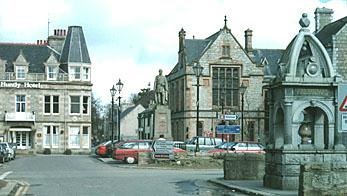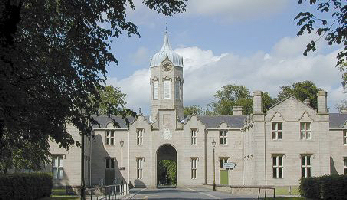|
|
|
Purcell and Elmslie, Architects Firm active :: 1907-1921
Minneapolis, Minnesota :: Chicago,
Illinois |
Ye Older Grindstones
Childhood home of George Grant Elmslie
Huntly Square
Huntly, Scotland
Image credit: The Gordon Schools websiteElmslie alma mater
Gordon Schools
Huntly, Scotland
Image credit: The Gordon Schools websiteConfessio . In the field of archival documents, George Grant Elmslie seems as mysterious in his presence as Purcell is straightforward. Qualities of character can be more easily ferreted out with Purcell partly because vastly more of his personal records survive to reveal background origins and the process of maturation, and partly due to his candor in extensive deliberations about his life experience. Without question, Elmslie pondered in great depths but alas his passages were less churned in the pages of the written word by comparison. A n array of ironies can be discerned behind all of this: Purcell wrote much and concealed a little, Elmslie wrote relatively little and revealed a lot -- one did so intentionally and the other not so much.
However copious the stream, all is not as the fount might seem with Purcell. He premeditated our resident state of affairs by separating out what was ours to know -- architecture and those who moved forward the Caravan -- and what he felt was not, including some subterranean personal and family concerns determined to be none of our business. He did this by not mentioning his deletion of documents, perhaps amounting to only a small number whose absence would be indiscernible against the voluminous quantity being donated to our prizing minds. Only when Purcell relied on the hands of others (notably, and thankfully, John Jager, who sometimes refused) for destruction can we find tantalizing notation of these removals. Elsewhere we are left to walk upon the water of inference or tumble into the bog of speculation about what information we may have been denied.
To aid in our journey toward acquaintance with Elmslie we have far fewer documents, the majority of which consists of his personal correspondence. Certainly nothing was ever created by him like the core of introspections and revelations accumulated by Purcell over a long and active cascade of musing in manuscripts, diaries, notecards, glosses, letters, audio recordings, self-published pamphlets and individually crafted presentation books. Purcell could most likely not edit away all traces of anything, even though quite possibly he tried, as there might be just too many unconsciously forgotten places to look. His motivations were, usually, simply generous: he didn't want to give historians downstream an undue negative impression of someone because of deficiencies whose mention was unwarranted on a fine presumption of irrelevance to the Cause. Purcell was a gentleman. The very least he could do was acknowledge that a person had shown up, even if no substantial contribution can be truthfully attributed. When a stray surviving scathing document by his hand surfaces, such as a fragmentary manuscript describing his impression of George Feick, Jr., the honesty contrasts so extremely with an otherwise consistent party line that we can only wonder what rare wealth the trash can intercepted before our eyes came into the mix.
Elmslie left us more needy. He scarcely sideswipes with the occasional annotation, and that with a cursive scratch which in places even Champollion might have had difficulty reading. Clearly, the written word was to Elmslie the lesser Hinayana vehicle of self-expression, where therein Purcell was Oscar Wilde's prose poet taking daily exercise. Elmslie resorted to words when they were most explicit or appropriate in function, but how quickly and easily his pen dipped into a Mahayana fluidity of image when something of the heart called to be illustrated with more precise eloquence. Letters to family members, his nieces for example, are often decorated with humorous animals drawn upon a page where even abundant words are merely captions to loving feelings expressed in the humorous lines of the drawings. When Elmslie slummed about with words, the resulting poetry was lyrical and often playful: his reveal to us of what mattered in life, one not infrequently touched by dewdrops of wistfulness.
Beyond the drafts that became Elmslie's publications, which in one sense are processed meats sandwiched by other hands, there are only a very few raw biographical manuscripts. One of these bears witness to Elmslie's natural attitude of self-effacement in the form of a post-typist handwritten annotation:
This is NOT very interesting to anyone I fear. Ho Hum. VERY DRY and only meant as mere NOTES anyway for someone to enlarge on. Keep it anyway. (1)
Modesty is a traditional Scots virtue. As Elmslie makes clear in these pages, he may have come to America but like all emigrant Scots throughout the world his mindset was always tenaciously nurtured from original root tendrils in the culture and natural environment of the Highlands. In his recollection of things about the Scotland of his youth, Elmslie tells us both of his pride of tribe and the profound embrace of Nature in his childhood experiences. He recalls what was important to him, what impressed him as singular and lasting in value -- virtuous -- and these things therefore are our welcome telltales. Not Ho Hum, indeed, nor very dry.
Yet, to me, this document also has a very important sleeper of a paragraph:
"The Scots are a reticent lot, even taciturn at times, but with a little patient digging and forbearance one may find a substratum of the mystic, especially among the northern or highland Scots. In that purely Celtic element as it exists in lesser degree in many nations may be envisaged the hope of the world. We believe that science is fast climbing the last barrier of materialism, as witness the writing of Jeans and Eddington; and the world of matter as we now appear to see it is crumbling, dissolving, disappearing. What is left? The Celt will answer a spiritual entity, no more, no less." (2) [italics mine]
What the Bleep, la George Grant Elmslie, himself included in the we of we believe. Here GGE comes as close as he will to a confession central to our study: his mystical belief in the innate interrelationship between spirit and matter, a view he considered validated by modern scientific thought. The explicit reference to scientists Arthur Eddington (1882-1944) and Sir James Hopwood Jeans (1877-1946), whose works sought to bind quantum and celestial mechanics into an understanding of the nature of consciousness, provides a substantiating glimpse toward a point I made in the "Purcell and Elmslie, Architects" monograph published in 1994 when I noted:
The message of inescapable interrelationship that lay at the heart of the most powerful modern scientific insights, from Einstein's theory of relativity to the psychological writings of William James, directly contradicted the view of scientific reductionism. Whether or not this realization rose to full consciousness in the work of any given progressive architect--clearly some made the intellectual connection--the work of the Prairie architects benefited. William Gray Purcell and George Grant Elmslie were among those who figured the puzzle out and rendered their answer in architectural design. (3)
Eddington led the expedition to Principe Island which validated the prediction in Einstein's Theory of Relativity that gravity bends light, and Einstein himself called Eddington's 1923 book Mathematical Theory of Relativity, "...the finest presentation of the subject in any language." Reticent or modest Scot that he was, Elmslie may have demurred complete understanding of his bedtime reading, calling the denser passages superb "soporifics" (4), but he was eating at the Ritz. Reductionism, the inevitable outcome of a Newtonian world view, was obsolete over a hundred years ago. Purcell and Elmslie were already there, head and heart. George Elmslie bothered to tuck in a few words confirming same in one rare foray into autobiographical notes.
Other additions, corrections, and updates: To present a sample of the writings of Alice Meynell mentioned so happily by Elmslie in the above reviewed manuscript, a new section called The Sampler has been created to which further such incidental authors can be added in the future. Purcell and Elmslie often cite people whose works they enjoyed but which are not directly relevant to P&E architectural history. I thought it would be nice to have a tasting station. Although the amount of time available for the Grind this week is spent, I will continue to add excerpts and links to sources for other authors referenced by Elmslie in the manuscript.
Also, I corrected a faulty link to PDFs of the entire Houses and Gardens by H. M. Baillie Scott (George Newnes, Ltd. 1906). Both Purcell and Elmslie were familiar with this seminal English book, and the work is mentioned in the Parabiographies.
Bon appetit!Next up: The Fellowship of the (Prairie School Web) Ring.
4/11/2006
La Pome.
The relationship between beauty and
spiritual truth (Hint: they are one and the same thing) is at the very
heart of understanding Purcell and Elmslie. Without question, the greatest
advertisements going for the Caravan are the mellifluous enrichments from
the mind, body, and soul of George Grant Elmslie that grace, sometimes
encrust Sullivan and P&E buildings. Whether in the form of terra-cotta,
wood, glass, stencil, textile, metal, or on paper, these decorative
designs are the easiest entrance into the realm of beauty wherein our
heroes set up the tent of their spirituality. Indeed, it was through the
magical terra-cotta entrance to the Merchants Bank of Winona that,
serendipitously, P&E first opened my eyes, even though it would be a year
before I even knew their names or anything else about them--as I sat down
in front of the boxes containing their archives for a work/study job at
the Northwest Architectural Archives in 1979. Yet both Purcell and Elmslie were
sensitive about the presence of decoration, in places even a little
defensive given the stark plunge of the architectural world into nudity
after all was done. They wrote careful bits of explanation, alluding to
the necessities integration and holism, to an audience wallowing in sheets
of glass and mechanical arrays of steel columns. They wanted only for
their work to be understood, not to tell the Internationalistas there was
something missing in the cool intellectual abstractions of engineering
posing as complete expressions of human spirit. As I work through my preparations for
writing the section in The Book on the role of beauty in the work of P&E,
documents long stored come to hand. One manuscript prepared by Purcell for
Wayne Andrews addresses the balance that the Team brought to Elmslie's
tendency to go overripe in decorative forms. The wealthy and large jobs in
the Sullivan office could absorb the costs of excess, thankfully, as
witnessed for example in the luxuriance of metalwork and sawed wood found
on the Schlesinger and Mayer store. However, as Purcell says in more than
one place, "Purcell and Elmslie had no such cloth to cut." Elmslie found what can be called a more
wholesome environment in his partnership with Purcell, one where many
hands were eager to support, even if that meant restrain, his eloquence. Afterwards during the early 1920s, when Elmslie began to let the seeds of
bitterness germinate into the pique of alienating such helpers, the
relationship of the part to the whole went from harmony to dissonance. In
a manuscript titled "Notes on Purcell and
Elmslie, Architects: 1910 - 1920," Purcell describes this unfortunate
outcome as particularly visible in the Capitol Building and Loan Association
(Topeka, Kansas 1922). Next up:
Elmslie in his own words.
Before P&E
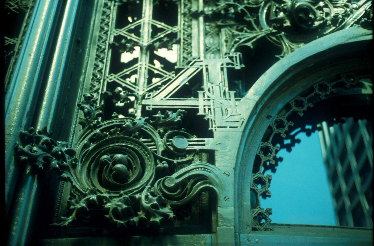
Detail, metal grille, front
entrance
Schlesinger & Mayer Dry Goods
Store
Later Carson, Pirie, Scott
later Carson, Pirie, Scott
Louis H. Sullivan and George Grant Elmslie, architects
Chicago, Illinois 1900/1903
During P&E
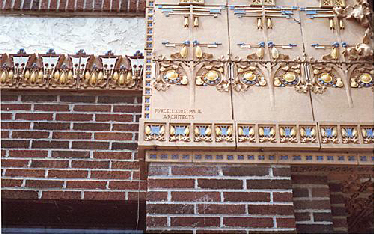
Detail, lower front entrance
Farmers and Merchants State Bank
Purcell and Elmslie
Hector, Minnesota 1916
Photograph courtesy John
Panning
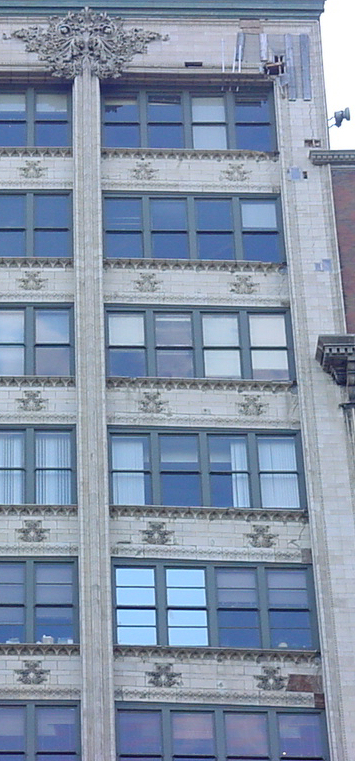
Gage Building, 2005In the good times,
however, the angels sang and the people listened. They are
listening still, but what "urban removal" of the 1950s and 1960s
didn't silence is being more slowly diminished in places by time.
Walking around downtown Chicago while
leading some UCLA design students on a tour, I was struck by how
many buildings with terra-cotta sheathing are in overtly distressed
condition. Nowhere was this more visible, shocking, and foreboding than
the Gage Building, which is punctuated with some superb Elmslie-designed
enrichment. The foundations of the north side have subsided, causing a
twelve to eighteen inch drop of alignment across the horizontal members. The shearing has produced deep cracks, heavy flaking, and outright failure
of various terra-cotta elements. The Venetian Gothic Chicago Athletic Club
next door does not appear to be effected by this, so the problem is
apparently within the construction of the Gage Building itself, not the
ground in general.
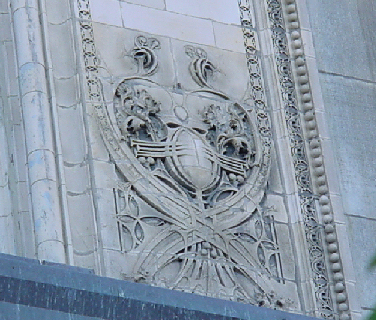
Column "root"
Gage Building, 2005
On the bright side, the
former Banquet Hall, now concert hall, at the Auditorium Building was
open to the footfall of strangers. I was astonished to see that the
long-vanished electroliers have been replicated within the space
proper. Hey, it's progress! Now on to the stencils. So in places
things are falling away, while in others they return in an echo. Vibrations with long waves. Also, in the
hall lobby I noticed for the
first time a sweet little painting by Albert Fleury, which has a
similar flavor to a canvas of the same vintage that Purcell bought
from Fleury to hang in Lake Place.
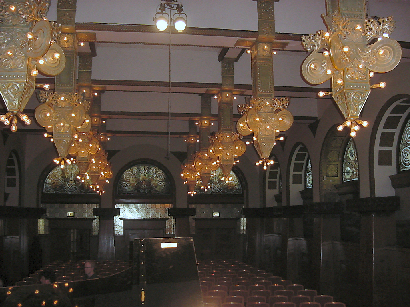
Banquet Hall (2005)
Auditorium Hotel
(now Roosevelt University)
Adler & Sullivan
Chicago, Illinois 1893
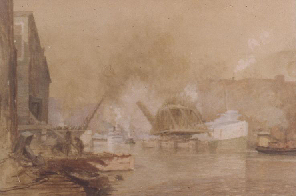
"Chicago River
Albert Fleury, artist
ca. 1900s
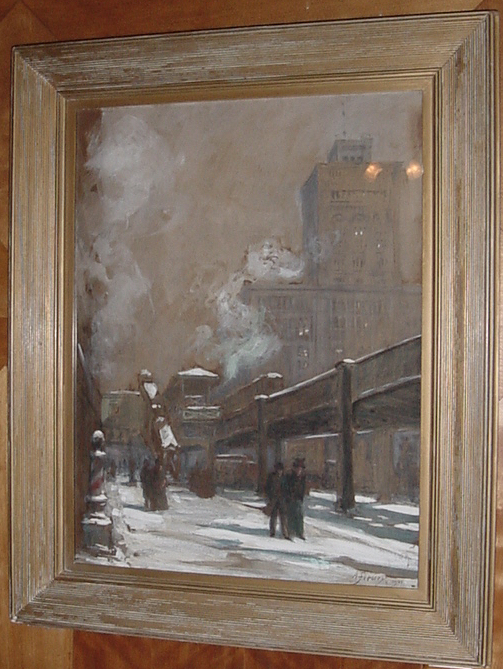
Winter street scene, showing the
Auditorium Building
Albert Fleury, artist
Oil on Canvas
1901
4/6/2006
Decoration for a Hall Breezing the horse. Many
fine books come newly to hand, such as David Van Zanten's Sullivan's City
and The Chicago Auditorium Building by Joseph M. Siry, demonstrate amply
that the Prairie-van continues to move forward. The
International Arts and Crafts exhibition at
the freshly minted de Young Museum in San Francisco follows closely on the heels
of The Arts and Crafts Movement in Europe and America curated by Wendy
Kaplan at the Los Angeles County Museum of Art in 2005. In both scope and
detail, awareness of the progressive movement extends in quantity and quality. One of the most invigorating aspects of these many new books and exhibitions
is the clear emphasis on integration of the American and European expressions as
aspects of a whole. Over a decade ago in the introduction to his Frank Lloyd
Wright: The Lost Years, 1910-1922 (University of Chicago Press, 1993),
Anthony Alofsin eloquently questioned the reigning academic myth concerning the
influence of Wright on the Europeans through the Wasmuth publications.
Both of the abovementioned exhibitions, while obviously embracing a particular
lyricism of the era, do much the same thing in a more general sense. Purcell & Elmslie managed a peephole in Kaplan's grouping with a single,
albeit of course very special, carpet from the Henry Babson residence, prompting
her to autograph my copy of the exhibition catalog with an apology for the
paucity of work by the firm. It is unseemly to lament, in lieu, the
comparative burgeon of Greene & Greene with 7 objects, since they are the native
California incarnation nearby LACMA, and only acceptance is possible toward the
inevitable superabundance of Frank Lloyd Wright (6 items). Still, LACMA owns a
fine sconce from the Babson house that could have taken up otherwise bare
gallery wall next to the rug from the same house, and that touch would have
nicely made the point of integrated design in a variety of materials; instead,
the sconce remained hung as usual in the main museum building across the way
next to their standard issue Merchants Bank chair and a very nice, large pre-P&E
Elmslie terra-cotta urn.
At the de Young, there is again a single item. One of the venerable chairs
from Director's Room of the Merchants Bank of Winona squares off, almost
de rigeur, in the San Francisco venue. Though any presence is a
good thing, I admit that I wish something more eloquent than that
oft-trotted chair had been chosen to represent our heroes. Yes, the piece
does clearly illustrate what Purcell was talking about when he expressed
dismay that P&E is often lumped into the Arts and Crafts category, so in
that at least it is a good choice to show the poetic nature of the machine
for sitting and the underlying means of production via machines
rather than handicrafts. I think a much better selection in the
context would have been the Babson sleeping porch chair, shorn of that pastel
blue fabric currently serving as cushion covers [although that itself is light
years better than the orange canvas which preceded it] and given the blessing of
a more lively colored silk that has less disharmony with the coloration of the
wood.
The Minneapolis Institute of Art does a superb job and has an shown an
exceptionally praiseworthy commitment in many respects through their
well-designed galleries and--of course--the preservation of Lake Place,
but one area where they have always been weak is understanding the bright
colors often used by P&E. During the years I served as historical
consultant on the restoration of Purcell's house, one moment exemplifies
this too conservative reserve toward vibrancy. Michael Conforti showed me
the restoration of the stencils in the dining room, noting the care with
which the newly repainted ones matched, in the sense of cleaning up, the
old ones. I told him that the original stencils were not time-dimmed
pastel in character, but had vivid primary colors. Naturally, being consummate and precise by nature, he
challenged me to prove that. I referred him to the original sunscreens for
the two glass-paneled doors leading out to the back porch. These had hung,
untouched by light, tucked in their holding hooks inside the two flanking
linen closets since the house was built. The red stencils painted on them
were as vermillion fresh as the day they were made seventy years earlier. Since the stated objective of the restoration was to bring the house back
to the period when the Purcells lived there, it seemed natural to me that
the stencils should shine, not shiver. The museum had taken everything
remaining which was original to Lake Place, including the carpets and
aforementioned sunscreens, to a distant off-site storage facility; believe
it or not, they couldn't find them at first. Once they did, however, the
stencils throughout the house were repainted as you see them today, with a
stretch of the faded ones left visible for comparison. The same thing happened with the little "Surprise Point"
chairs in the living room reading nook, of which one of the two remaining
originals appears in the museum gallery on permanent loan from the Purcell
Papers at the Northwest Architectural Archives. I sat on this chair
sometimes while working on the Purcell's manuscripts, and it still had a
shimmering green silk cushion chosen by Purcell in the 1950s that was,
unfortunately frayed, not suitable for display. The curator replaced that
fabric with a dark brown William Morris-esque patterned cloth, beneath
which the aspiration of the chair cowers, rather sings with the original
bright silk intention mentioned by Purcell in his writings. Also,
while I have been saddened that the stream of visitors to Lake Place
relishes the male/yang crystal patterns of the leaded glass without the
balance of the feminine/yin softness of the original translucent stenciled
and embroidered gauze curtains which should be part of the true
experience, part of me is fearful that should the curtains be installed
they would not hold their own with the glass patterns without the real
effort of getting the color saturation and hue right. Auctions of P&E body parts--er, objects have picked up,
most notably at Sothebys over the past two years. A companion rug to the
one in the LACMA exhibit was turned out of private hands recently for an
unspecified princely sum with a pre-sale estimate of $20,000-30,000. The
price of another fragment of the Babson house, a wooden grille, was also
undisclosed from an estimate of about $2,000. One of the Bradley house
dining room chairs, from a set whose seating pieces sometimes turn up as
old fraternity members who lived in the house pass away (wink, wink,
nudge, nudge, need I say more?), should be cherished by new owners who
disgorged $39,000 for the privilege of daily presence, if certainly not
usage. In all these things I cannot help but wonder when the dining room
doors from the Wiethoff house will wind up on sale somewhere, having been
wrenched bodily from their ancient moorings by a former owner as he
departed for lesser places.
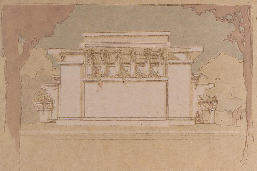
Rendering
Unity Temple
Oak Park, Illinois
Frank Lloyd Wright, architect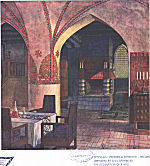
Gesellius, Lindgren and Saarinen
Helsingfors, Sweden Originally appeared in Moderne Bauformen,
Julius Hoffman Verlag, Stuttgart, Germany. Catalog of the Fourth
Exhibition, Pittsburgh Architectural Club (1907), unnumbered
plate.

Carpet
Henry B. Babson residence
Riverside, Illinois

Light fixture, 1912
Henry B. Babson residence
Riverside, Illinois
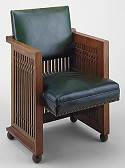
Chair
Merchants National Bank
Winona, Minnesota
Collection of the
Minneapolis Institute of Art
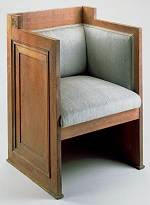
Chair
Henry B. Babson residence
Riverside, Illinois
Collection of the
Minneapolis Institute of Art

Carpet
Henry B. Babson residence
Riverside, Illinois

Wooden grille
Henry B. Babson residence
Riverside, Illinois

Pair of wickets
First State Bank
Leroy, Minnesota

Chair
Harold C. Bradley residence #1
Madison, Wisconsin
Next up: The parlous state of some
Elmslie terra-cotta ornament in Chicago, and a hidden Albert Fleury
painting.![]() research courtesy mark hammons
research courtesy mark hammons

